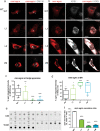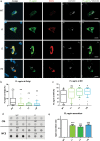Severe congenital myasthenic syndromes caused by agrin mutations affecting secretion by motoneurons
- PMID: 35948834
- PMCID: PMC9468088
- DOI: 10.1007/s00401-022-02475-8
Severe congenital myasthenic syndromes caused by agrin mutations affecting secretion by motoneurons
Abstract
Congenital myasthenic syndromes (CMS) are predominantly characterized by muscle weakness and fatigability and can be caused by a variety of mutations in genes required for neuromuscular junction formation and maintenance. Among them, AGRN encodes agrin, an essential synaptic protein secreted by motoneurons. We have identified severe CMS patients with uncharacterized p.R1671Q, p.R1698P and p.L1664P mutations in the LG2 domain of agrin. Overexpression in primary motoneurons cultures in vitro and in chick spinal motoneurons in vivo revealed that the mutations modified agrin trafficking, leading to its accumulation in the soma and/or in the axon. Expression of mutant agrins in cultured cells demonstrated accumulation of agrin in the endoplasmic reticulum associated with induction of unfolded protein response (UPR) and impaired secretion in the culture medium. Interestingly, evaluation of the specific activity of individual agrins on AChR cluster formation indicated that when secreted, mutant agrins retained a normal capacity to trigger the formation of AChR clusters. To confirm agrin accumulation and secretion defect, iPS cells were derived from a patient and differentiated into motoneurons. Patient iPS-derived motoneurons accumulated mutant agrin in the soma and increased XBP1 mRNA splicing, suggesting UPR activation. Moreover, co-cultures of patient iPS-derived motoneurons with myotubes confirmed the deficit in agrin secretion and revealed a reduction in motoneuron survival. Altogether, we report the first mutations in AGRN gene that specifically affect agrin secretion by motoneurons. Interestingly, the three patients carrying these mutations were initially suspected of spinal muscular atrophy (SMA). Therefore, in the presence of patients with a clinical presentation of SMA but without mutation in the SMN1 gene, it can be worth to look for mutations in AGRN.
© 2022. The Author(s).
Figures









Similar articles
-
LG2 agrin mutation causing severe congenital myasthenic syndrome mimics functional characteristics of non-neural (z-) agrin.Hum Genet. 2012 Jul;131(7):1123-35. doi: 10.1007/s00439-011-1132-4. Epub 2011 Dec 29. Hum Genet. 2012. PMID: 22205389 Free PMC article.
-
A valid mouse model of AGRIN-associated congenital myasthenic syndrome.Hum Mol Genet. 2011 Dec 1;20(23):4617-33. doi: 10.1093/hmg/ddr396. Epub 2011 Sep 1. Hum Mol Genet. 2011. PMID: 21890498 Free PMC article.
-
Novel SEA and LG2 Agrin mutations causing congenital Myasthenic syndrome.Orphanet J Rare Dis. 2017 Dec 19;12(1):182. doi: 10.1186/s13023-017-0732-z. Orphanet J Rare Dis. 2017. PMID: 29258548 Free PMC article.
-
Synaptic basal lamina-associated congenital myasthenic syndromes.Ann N Y Acad Sci. 2012 Dec;1275:36-48. doi: 10.1111/j.1749-6632.2012.06807.x. Ann N Y Acad Sci. 2012. PMID: 23278576 Review.
-
Current status of the congenital myasthenic syndromes.Neuromuscul Disord. 2012 Feb;22(2):99-111. doi: 10.1016/j.nmd.2011.10.009. Epub 2011 Nov 21. Neuromuscul Disord. 2012. PMID: 22104196 Free PMC article. Review.
Cited by
-
Delivery of Prime editing in human stem cells using pseudoviral NanoScribes particles.Nat Commun. 2025 Jan 4;16(1):397. doi: 10.1038/s41467-024-55604-0. Nat Commun. 2025. PMID: 39755699 Free PMC article.
-
Rare disease research workflow using multilayer networks elucidates the molecular determinants of severity in Congenital Myasthenic Syndromes.Nat Commun. 2024 Feb 28;15(1):1227. doi: 10.1038/s41467-024-45099-0. Nat Commun. 2024. PMID: 38418480 Free PMC article.
-
Unlocking the Complexity of Neuromuscular Diseases: Insights from Human Pluripotent Stem Cell-Derived Neuromuscular Junctions.Int J Mol Sci. 2023 Oct 18;24(20):15291. doi: 10.3390/ijms242015291. Int J Mol Sci. 2023. PMID: 37894969 Free PMC article. Review.
-
Congenital myasthenic syndromes in adults: clinical features, diagnosis and long-term prognosis.Brain. 2024 Nov 4;147(11):3849-3862. doi: 10.1093/brain/awae124. Brain. 2024. PMID: 38696726 Free PMC article.
-
The striatal heterogeneous nuclear ribonucleoprotein H mRNA targetome associated with methamphetamine administration and behavior.bioRxiv [Preprint]. 2025 May 29:2021.07.06.451358. doi: 10.1101/2021.07.06.451358. bioRxiv. 2025. PMID: 40502192 Free PMC article. Preprint.
References
-
- Bouchecareilh M, Marza E, Caruso M-E, Chevet E (2011) Small GTPase Signaling and the unfolded protein response. In: Methods in enzymology. Elsevier, pp 343–360 - PubMed
Publication types
MeSH terms
Substances
LinkOut - more resources
Full Text Sources
Research Materials

